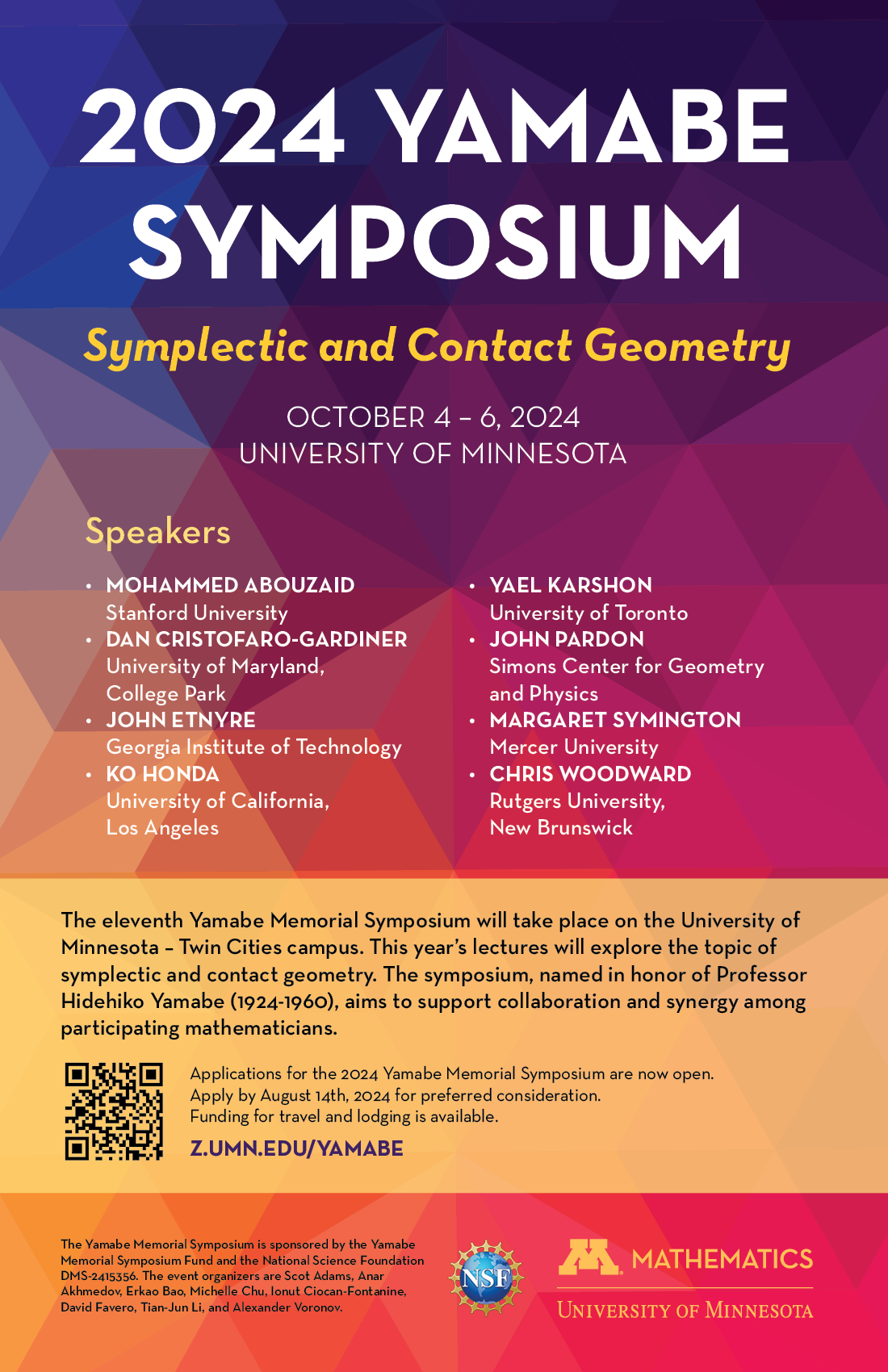Yamabe Memorial Symposium

2024 Yamabe Memorial Symposium: October 4 - 6, 2024
The School of Mathematics will host the eleventh Yamabe Memorial Symposium from October 4th to Sunday, October 6th, 2024, on the University of Minnesota–Twin Cities campus. This year's program will focus on the topic of Symplectic and Contact Geometry. Speaker abstracts and the event schedule will be posted when details become available.
Speakers
- Mohammed Abouzaid (Stanford University)
- Daniel Cristofaro-Gardiner (University of Maryland, College Park)
- John Etnyre (Georgia Institute of Technology)
- Ko Honda (University of California, Los Angeles)
- Yael Karshon (University of Toronto)
- John Pardon (Simons Center for Geometry and Physics)
- Margaret Symington (Mercer University)
- Chris Woodward (Rutgers University, New Brunswick)
Organizers
- Scot Adams
- Anar Akhmedov
- Erkao Bao
- Michelle Chu
- Ionut Ciocan-Fontanine
- David Favero
- Tian-Jun Li
- Alexander Voronov
Location
The 11th Yamabe Memorial Symposium: Symplectic and Contact Geometry will take place in Vincent Hall at the University of Minnesota in Minneapolis, MN.
The Yamambe Memorial Symposium is funded by the Yamabe Memorial Symposium Fund and the National Science Foundation DMS-2415356.
History
Professor Hidehiko Yamabe (1924-1960) came to Minnesota from IAS as an assistant professor in 1956. During his four years here he worked on a number of diverse topics in geometry and analysis: he initiated the problem of whether, given a Riemannian metric on a smooth compact manifold of dimension > 2, there exists a conformally equivalent metric of constant scalar curvature; he made contributions to Hilbert's 5th problem and various diffusion problems. Yamabe died in 1960, at age 37, of a massive stroke, said to have been brought on by war injuries as a civilian. This tragedy happened soon after he was appointed a full professor at Northwestern University. Yamabe's widow and two young daughters were left virtually penniless as Yamabe no longer had a pension from Minnesota and hadn't yet gained one from Northwestern. Faculty of both Northwestern and Minnesota raised a small amount of money to help the family, who then moved back to Japan.
The Yamabe Memorial Lecture was initiated jointly with Northwestern about 1962. It consisted of one lecture by a prominent mathematician each year, to alternate between Northwestern (odd numbered years) and Minnesota (even years). It was soon supported by a small subsidy from Yamabe's widow (this initial donation was later augmented in Minnesota by significant faculty contributions resulting in the present endowment called the Yamabe Fund). The distinguished speakers brought in year after year established the Lectures as an important event in the mathematical calendar, especially in the Midwest.
Past speakers include Neil Trudinger, Eugenio Calabi, Rick Schoen, Shizuo Kakutani, Craig Evans, Walter Rudin, Robert Hardt, Katsumi Nomizu, Fred Gehring, Richard Hamilton, Peter Sarnak, Jeff Cheeger, Shing-Tung Yau, Terence Tao, Igor Rodnianski, Luis Caffarelli, Tai-Ping Liu, Sergiu Klainerman and Simon Brendle.
Hidehiko & Etsuko Yamabe

Hidehiko, Etsuko & Kimiko Yamabe

Hidehiko Yamabe (right)

